Stan VanDerBeek and Ken Knowlton at Bell Labs collaborated on a series of digital structuralist computer/graphic/text animations in 1966. They used BeFLIX, [Bell Flicks], an 8-bit graphics programming language Knowlton developed in 1963.
The Tate’s clean version of Poemfield No. 2 isn’t loading right now, so here’s the YouTube version:
Meanwhile, go back to the Tate’s site for several other crisp copies of VanDerBeek’s works.update: Fuller, VanDerBeek, Cage, I’m just following Steve Roden around. Check out the collection of 1967-8 event posters from the University of Illinois he just posted.
Category: making movies
The Not So Spiral Jetty
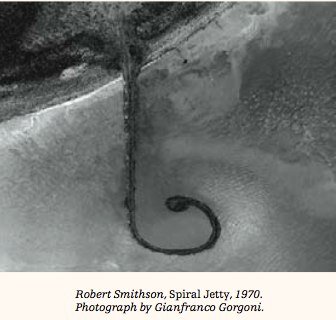
For a generation of art watchers, Robert Smithson’s Spiral Jetty existed primarily as an image, via the making-of film and Gianfranco Gorgoni’s iconic aerial photographs, which were exhibited at MoMA’s seminal Information show and were published in Smithson’s Artforum essay on the work. This mediated encounter with the work inevitably affected its interpretation. But similarly, the 16 years of visibility and visitability since the Jetty’s re-emergence from the Great Salt Lake can lull you into a sense of complacency that you now know the work. And by you, of course, I mean me.
The latest issue of the Smithsonian’s Archives of American Art Journal includes an excellent essay, “Spiral Jetty through the Camera’s Eye,” by doctoral candidate Kathleen Merrill Campagnolo, which looks at how Smithson used photography and film to shape not only the reception of the Jetty, but its conception and evolution as well.
For example, at first, and even until a week after it was supposedly completed, it wasn’t actually a spiral. The image above is from a contact sheet Gorgoni took in April 1970. It shows the Jetty:
…with a single, simple curve to the left, creating a hook shape with a large circle of rocks at the end…In a recently published account of the construction of the sculpture, the contractor Bob Phillips reveals that Smithson considered this first curved jetty, as seen in Gorgoni’s photographs, to be complete, but about a week after the construction crew had been sent away, he called them back to alter the configuration…
…Not surprisingly, the early version of the sculpture was not included in any of Smithson’s Spiral Jetty works. In fact, by the time he had finished his essay in 1970-71, the text reads as if the form the jetty took was a foregone conclusion from his first arrival at Rozel Point.
Campagnolo’s article has another Gorgoni photo, of Smithson and Richard Serra looking at a lost/destroyed sketch of Jetty v1.0 with v2.0 superimposed on it.
To see the sketch, you should really read the article. But I am reproducing the top half of the image here because I am in awe of Serra’s impressive Jewfro.

PDF: Vol 47: 1-2, The Archives of American Art Journal [aaa.si.edu via the Archives of American Art Blog Really? Yes. It’s awesome. [blog.aaa.si.edu, probably via tyler green, since it mentions hockey]
On Printing German Wallpaper & Richter’s Film
For their “Art of Two Germanys” show in 2008, LACMA recreated part of a 1966 gallery installation by Gerhard Richter called Volker Bradke, which was designed to mimic or reference the postwar German bourgeoisie’s penchant for ticky tacky floral wallpaper.
But instead of real wallpaper, the museum used an artifact from the original installation, loaned by the piece’s owner via the gallery: a rubber stamp roll with a design carved into it. LACMA’s curator and gallery manager talk here about printing up the walls, but for some reason, I just can’t get enough of this video of them actually doing it.
This reminds me a bit of Christopher Wool, and it’s a fantastic-looking method of generating an image. Or a design, or a surface, whatever you end up calling it. The fact that it’s a painted simulacrum and not actual wallpaper, though, seems pretty relevant, as does the curator’s instruction that “the printing is not supposed to look perfect.” It sounds like an early example of Richter reminding the viewer that he’s looking at an image, not the thing itself.
Anyway, this is all coming down today because Bradke is the subject of Richter’s only film, a 14-min black & white short which was part of the installation. It’s just been released on DVD, along with a book, »Volker Bradke« und das Prinzip der Unschärfe [“Volker Bradke and the Uncertainty Principle] by art historian Hubertus Butin. From what I can tell, the whole project was designed to turn Richter’s friend and studio assistant into a celebrity, using paintings, posters, banners, and a fawning profile film. We’ll see how the film turns out when it arrives; but so far, Richter doesn’t seem too compelled to revisit the medium. [via @gerhardrichter]
Wallpaper in Art of Two Germanys, part II [lacma blog]
As Seen On TV: Echo II Satelloon Inflation Video
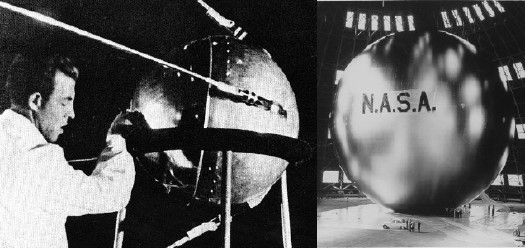
I’ve been searching for historical and primary source material for Project Echo, one of NASA’s earliest missions, which kicked into high gear in 1958. The giant, inflatable satelloons were functional–passive reflection communication satellites. That they were shaped just like Sputnik, only a hundred thousand times bigger, and were visible to the entire world with the naked eye, were, I’m sure, just a happy Space Race coincidence.
Echo I [above, right] was 100 feet in diameter and launched in 1960. Echo II was 135 feet, and launched in 1964. By then engineers at NASA’s Langley Research Center figured out that over-stressing the aluminized Mylar would help the giant sphere keep its shape, even if it deflated a little bit. [Echo I was found to have partially caved in a few months after launch.]
Film and TV cameras were included in the Echo II rocket–the film canisters were recovered in the ocean, but I haven’t found images from the footage. Video of the Echo II Inflation, however, is right here. Retired Goddard engineer Ron Muller screened it as part of a history of The Echo Project at a 2004 NASA conference on solar sails. It’s pretty awesome, right down to the end. [The avi is available for download at the conference page.]
I put a little film strip together after the jump, too:
Continue reading “As Seen On TV: Echo II Satelloon Inflation Video”
Danish Moisture Farmers
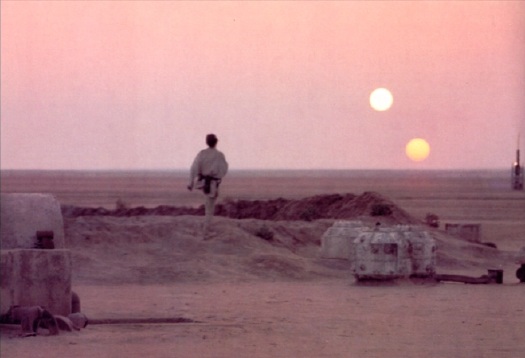
Ten years, people. That’s how long it took me to spot this. Ten. Years. What can I say, I got no excuse. I let you down.
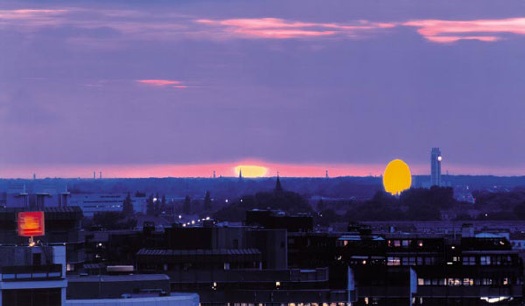
Olafur Eliasson, Double Sunset, 1999 [olafureliasson.net]
While I’m on the topic, my friend John Powers has been killing it with his new blog Star Wars Modern.
You may know him from such web awesomeness as Star Wars: A New Heap, which he published on Triple Canopy last year. Clearly, there’s more where that came from.
IKEA X Michelangelo Antonioni Mashup: The IVAR Dolly
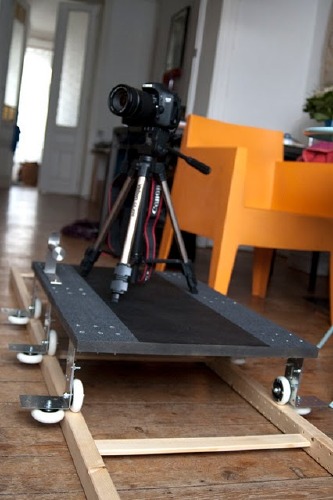
So awesome. With a few skateboard wheels, some L-brackets, and some grip tape, Brussels-based videographer VJ Aalto turned the ladder-shaped side bracket from Ivar, my Ikea component system of choice, into a EUR18 dolly track.
The great-looking test videos are on Vimeo, and the complete parts list is
in the comments on Ikeahacker.
EOS 7D + DIY dolly / 1st indoor test from Aalto on Vimeo.
Hey, look, next to the window, another bookshelf waiting to be sacrificed! Run it from the ceiling for a Professione: reporter remake!
Ivar loves dolly [ikeahacker via @MatthewLangley]
Ashes To Ashes, Toast To Toast
So I was watching Marie Lorenz’ video, Capsized, on WNYC’s Culture Blog, like I was told to do.
And not just because she had co-curated Invisible Graffiti Magnet Show inside those Richard Serra torqued spiral segments stored along the Bronx waterfront, I clicked through to see photos from Lorenz’ less harrowing journeys down the Tiber in her handmade boat.
Including Tiber River III, where she and a colleague from the American Academy look into the Protestant cemetery at Keats’ grave.
Which contains the epitaph that ends, “Here lies One Whose Name was writ in Water,” which prompts Lorenz to wonder what it means.
“I’m not really sure.” said Margaret. “Something about spirituality maybe, or the eternal nature of art. Its just good writing.” She said.
Well, the last one out of three, sure, but. So I looked it up.
And the full inscription overexplains it a bit:
This Grave
contains all that was Mortal,
of a
YOUNG ENGLISH POET,
Who,
on his Death Bed,
in the Bitterness of his Heart,
at the Malicious Power of his Enemies,
Desired
these Words to be engraven on his Tomb Stone:
“Here lies One
Whose Name was writ in Water.”
th
Feb 24 1821
Which makes wonder if Keats was murdered by his editor.
No, The Phrases Finder entry from 2003 tells me that Keats, 25, whose tuberculosis was not, in fact, getting better on his winter trip to Italy, and whose pursuit of true love was thwarted by his poverty, composed the last bit, at least, as a reference to a line from a Jacobean tragicomedy called “Philaster, or Love Lies-Ableeding,”: “All your better deeds/ Shall be in water writ.”
Which is spiritual in an “All we are is dust in the wind,” sort of way, I guess.
But then the Google Ad next to this epitaph is from an outfit called westmemorials.com:

She was everything to you
Mark her history
with something more
than a gray toaster-shaped
memorial.
Which, Bread of Life and all, maybe is something about spirituality, but really, it’s just good writing.
Neto > Bloc > Klein
While poking around last night looking for more films and videos made by Ernesto Neto, I found this clip, a black & white making-of short for Looking for the end, an installation Neto made in the southern Paris suburb of Meudon in 2007.
For Looking for the end Neto filled Andre Bloc’s 1964 Habitacle with a construction of giant Octon-shaped elements cut out of strandboard
The look of the film–by Benjamin Seroussi, who grew up in Bloc’s house, and whose dealer/collector mother Natalie Seroussi commissioned Neto’s piece–echos very nicely with the Habitacle’s most famous on-screen appearance, in the opening scene of William Klein’s awesome 1966 debut feature, Who Are You, Polly Maggoo?
Who Are You, Polly Maggoo? is a Cold War fashion satire, the freakishly beautiful lovechild of a post-protest march hookup between Funny Face and Dr Strangelove. It’s bizarre to think it came out the same year as Blow-Up.
Klein used Bloc’s post-constructivist brick pile as the stage for a ridiculous fashion show, where models inserted or bolted into creations of razor-sharp, polished metal [by Paco Rabanne, of course] paraded in front of magazine editors perched on scaffolding. In the post-show scrum of designer adulation, the Diana Vreeland character proclaims, “Je suis galvanisée!”
The opening’s on YouTube, but it turns out Criterion released Who Are You, Polly Maggoo? in 2008 as part of a 3-title box set, Eclipse Series 9 – The Delirious Fictions of William Klein.
The Battle of Hürtgen Forest
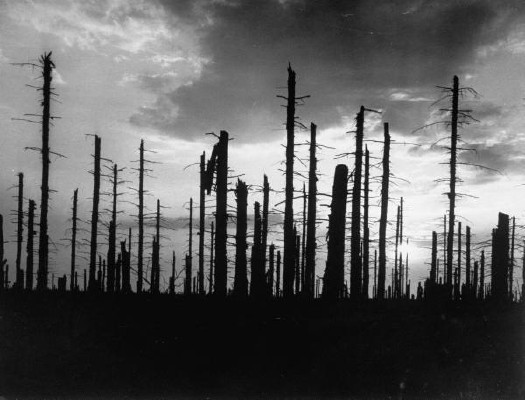
For the Allied forces, The Battle of Hürtgen Forest was the longest and one of the bloodiest, most pointless battles of World War II. Between October 1944 through February 1945, over 33,000 US soldiers were killed in the dense fir forest filled with minefields and fortifications.
Even when the battle turned immediately hellish, far-off Allied generals kept pressing for “victory,” which at the time basically meant preserving the pride of the US Army by not retreating, even though there was no apparent strategic value to the German territory.
At least that’s Charles Whiting’s point in The Battle of Hürtgen Forest, his harrowing-to-overwrought, GI-friendly history, published in 2000. [I bought my copy on Amazon.]
As Wikipedia points out, though, Germany suffered almost as many casualties defending the forest because it stood between the US and a potentially vital dam, and it was a staging ground for the fast-approaching Ardennes Offensive/Battle of the Bulge.
Still, none of that was known or acted upon at the time by US forces, and it certainly wasn’t communicated down the line to the soldiers pinned down for days in their nearly useless foxholes.
The photos in Whiting’s book are somewhat cursory, and when I imagine the conditions, I inevitably fall back to the episode on the wintertime siege of Bastogne from HBO’s Band of Brothers. So Dmitri Kessel’s 1951 photo for LIFE, depicting the bombed out, burned out ruins of the once-impenetrable forest kind of caught me off guard.
My great uncle Lark was a staff sergeant in Hurtgen Forest. He’d already fought in Africa, Sicily and France when he was killed on October 9th, one of the earliest casualties of the battle. When it published his obituary a month later, The Richfield Reaper (UT) said only he died “somewhere in Germany.” I’m not sure if anyone in my family has ever inquired after or discussed Uncle Lark’s experience during the last months and days of his life. But I suspect it was pretty damn grim.
Hurtgen Forest, Germany, 1951, photographed by Dmitri Kessel for LIFE Magazine [life@google]
The Battle of Hürtgen Forest [wikipedia]
Gehry & Calatrava: The Set Designers Meet Sivaji: The Boss
Spectacularious music video for “Style,” a song from Shankar’s Sivaji: The Boss [2007], the most expensive and highest grossing Indian film in history. It was shot on location in Spain, and stars Rajnikanth [b. 1950], the superstar of Tamil cinema, as a–oh, who cares what the plot is? We’ve come a long way from watching bad VHS dubs on “Namaste America” [Saturday night on Manhattan Cable’s leased time channel], let me tell you.
This was my favorite production blurb from Sivaji: The Boss:
5. The team of Shankar saw important footages of most of Rajnikanth’s films since his debut in 1975. They found that Rajnikanth looked best in Padikkadavan (1985) film. Then Shankar summoned the make-up artist to come up with a similar hairdo for Rajnikanth 22 years later.
6. Rajnikanth donned 15 different hair styles for this film. He also tonsured his head and shaven off his mustache for a get-up in this film. A make-up artist from France is flown in for this purpose.
Until I found this. Turns out they used CG to lighten Rajnikanth’s skin in “Style,” to show “how the superstar would look had he been a European.” They cloned the skin tone of a British backup dancer frame by frame. Took over a year.
Which I guess makes Rajnikanth the Tamil Bruce Willis and Sivaji: The Boss the Indian Hudson Hawk.
Here’s a higher-quality version of “Style” than the one at everythingisterrible.com. [via afc]
The Player
I can’t say how I feel about Francesco Vezzoli’s work; that’s not how my mama raised me. I will grant though, that he’s extremely smart and astute and has successfully identified an elemental dynamic of the art world and makes highly successful art that taps into that dynamic. OK, fine. his work embodies almost every superficial, vapid, self-unaware, pseudo-celebrity, luxury consumerist aspect I hate about the VIP Preview art world.
So bully for him that he’s turning the MoCA gala benefit tonight into the set for a performance/piece? This faux-ambivalent account of Vezzoli, his date/star Lady Gaga, and the preparations for the event in the LA Times makes for hilarious reading. I’m sure the event will be the biggest, starchasing cluster$%#& at MoCA since Tom Ford and Naomi Campbell turned the Takashi Murakami dinner into a commemorative plate-stealing riot.
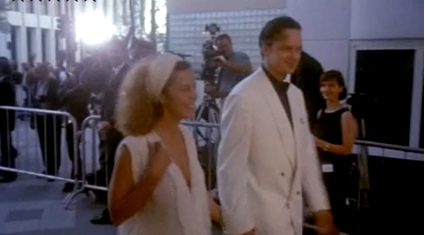
Alas, Vezzoli’s use of art to hustle celebrities into working for free unfortunately reminds me of someone I actually like: Robert Altman. To shoot the benefit scene in The Player, where Tim Robbins’ murderous studio honcho Griffin Mills is honored by several hundred of his best celebrity friends, Altman threw a real fundraiser for LACMA, complete with black & white dress code, then hustled all his celebrity friends to attend–then he filmed them for scale for his movie.
At least now I can finally make sense of Lady Gaga: she is post-op Cher.
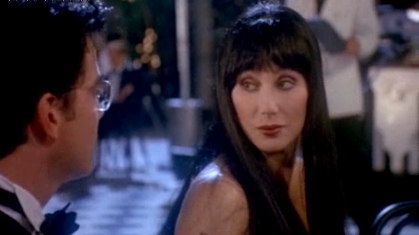
Francesco Vezzoli escorts Lady Gaga to MOCA’s gala [lat]
‘The Sound of Footsteps’
Tacita Dean on the making of Craneway Event, the rehearsals of the Merce Cunningham Dance Company in a former auto factory on the San Francisco Bay, which she filmed exactly a year ago:
I edited it alone on my film-cutting table using magnetic tape for the sound, which means you have to continually mark everything to keep the film in sync. The sound and image are separate, and the moment you lose sync it’s a nightmare: It’s just the sound of footsteps, which could be from anywhere in the film so it’s nearly impossible to find sync again.
17 hours of film edited down to 1h48, which fits nicely with the “longueur of some of [her] other films.” Looks and sounds fantastic.
Tacita Dean | 500 Words [artforum.com]
Craneway Event premieres Nov. 5-7 at St. Marks Church as part of Performa 09. [performa-arts.org]
The City As A Living Thing With A Giant Mailbox-Shaped Building In It
Hilary Harris’s 1975 Organism feels like a missing link in the chain of film portraits of New York City as a pulsing, living thing. Like Whitman, whose “Leaves of Grass” provided the text for their1921 film Manhatta Paul Strand and Charles Sheeler showed “million-footed Manhattan…descend[ing] to her pavements” and forests of buildings growing up to the sky. Then, by the time Godfrey Reggion made Koyaanisqatsi in 1982, the metaphor was solid enough to use the time-lapse photography Harris pioneered to diagnose the city’s terminal illness.
Maybe what modern city life needs to return it to full health is more post offices shaped like mailboxes. I combined frames from the various cuts of Harris’s slow, time-lapse pan in order to get a picture of the whole thing. Anyone know where this was?

Watch Manhatta and Organism at Ubu [ubu.com, via brian sholis]
Tripod-For-Handheld
Gruber calls this Windows 7 Launch Party video “cringe-inducing,” and it certainly is. Though I’m pretty sure the technical term for erratic, pointless, exaggerated simulation of handheld camera movement using a fixed camera and a pan handle is seizure-inducing.
That said, the dialogue is so bafflingly abstract, it’s almost sublime. I’m sure it’s because they didn’t have party “activities” website finished before the shoot, but this video could have a future as an insider’s critique of the corporate existential void. “Windows for Godot.”
Adolfo! Adolfo!
So I sneaked out last night to see Inglourious Basterds, which I found to be generally fantastic; Brad Pitt’s craft has come a long way since Meet Joe Black.
Because, I confess, I’m still working through a stack of badly panned & scanned DVDs of lost grindhouse epics, I have fallen behind in my study of spaghetti westerns and the lesser-known works of Lee Marvin. And so I was worried that Tarantino’s many subtle, referenzia cinematografistica which so many esteemed critics alluded to might slip by me unnoticed–and if that happens, what’s the point, right?
I needn’t have worried. From the twangy, scratchy get-go, where the opening track sounded like it was being played back on Hi-Fi to mimic the apparently primitive audio post-production facilities of Italy [1], Tarantino is not shy–hah, as if–about his stylistic references.
Oh, and contrary to some opinions, I thought Mike Myers was spot-on. I’d always joke-assumed Pitt won the Travolta/Forster/Carradine/Russell casting lottery this time as the actor whose forgotten talents and fizzling career would be nobly rescued by the director fanboi who Never Forgot. But I was wrong; it’s Myers. You now have at least two years where we won’t hold The Cat In The Hat against you, Mike. Use them well.
Anyway, the point, and the thing I either overlooked or never heard, was what a big, fat, sloppy kiss to the cinema this thing was. And not just the blatant, “Make me a Cannes juror for life!” applause line [“I’m French. We respect directors in this country.”] either. I’m talking about how the whole plot is basically the basterd child of The Dirty Dozen and Cinema Paradiso.
Also, *SPOILER ALERT?* was there NOT a shoutout to the end of Raiders of The Lost Ark? Does this mean Tarantino’s officially moved onto hommaging 80s pop film now? I see Michael Schoeffling as Robert Forster.
[1] Whenever he gets around to making it, I’m sure QT’s Punjabi murder musical will sound like it was recorded in the bathtub.
